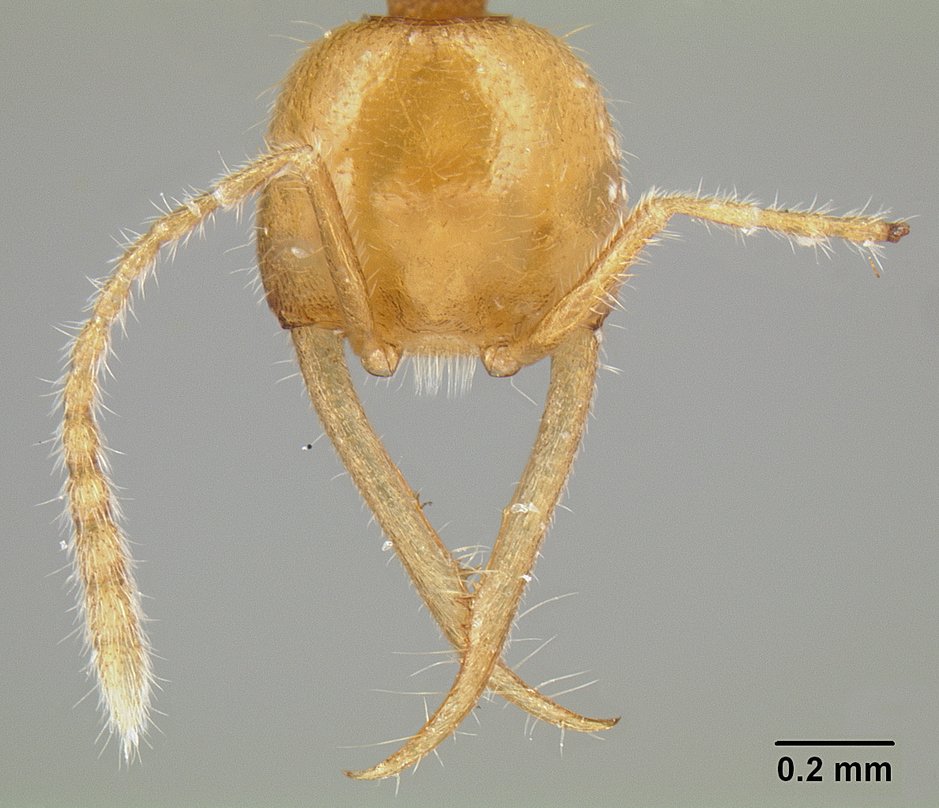Martialinae on:
[Wikipedia]
[Google]
[Amazon]
''Martialis heureka'' is a
 Like all members of the family Formicidae, these ants have distinctive geniculate (elbowed) antennae, prominent metapleural glands, and distinctive petioles. The ants, though, lack compound eyes, are pale in colour, and lead a subterranean life, preying on small litter organisms. The workers have unusual, elongated
Like all members of the family Formicidae, these ants have distinctive geniculate (elbowed) antennae, prominent metapleural glands, and distinctive petioles. The ants, though, lack compound eyes, are pale in colour, and lead a subterranean life, preying on small litter organisms. The workers have unusual, elongated
species
In biology, a species is the basic unit of classification and a taxonomic rank of an organism, as well as a unit of biodiversity. A species is often defined as the largest group of organisms in which any two individuals of the appropriate s ...
of ant
Ants are eusocial insects of the family Formicidae and, along with the related wasps and bees, belong to the order Hymenoptera. Ants evolved from vespoid wasp ancestors in the Cretaceous period. More than 13,800 of an estimated total of ...
discovered in 2000 from the Amazon rainforest near Manaus, Brazil
Manaus () is the capital and largest city of the Brazilian state of Amazonas. It is the seventh-largest city in Brazil, with an estimated 2020 population of 2,219,580 distributed over a land area of about . Located at the east center of the st ...
. It was described as a new species and placed as the sole member of a new subfamily, Martialinae. The generic name means "from Mars
Mars is the fourth planet from the Sun and the second-smallest planet in the Solar System, only being larger than Mercury. In the English language, Mars is named for the Roman god of war. Mars is a terrestrial planet with a thin at ...
" and was given due to its unusual morphology
Morphology, from the Greek and meaning "study of shape", may refer to:
Disciplines
* Morphology (archaeology), study of the shapes or forms of artifacts
* Morphology (astronomy), study of the shape of astronomical objects such as nebulae, galaxies ...
, and the species epithet '' heureka'' indicates the surprising discovery. It belongs to the oldest known distinct lineage to have diverged from the ancestors of all other ants.
Etymology
The aberrant features of this ant led Stefan P. Cover and Edward O. Wilson to comment that it was an ant that had to be from Mars. The genus name, then, refers to the planet Mars, alluding to the strange characteristics that seem to come from nowhere; the species epithet is fromAncient Greek
Ancient Greek includes the forms of the Greek language used in ancient Greece and the ancient world from around 1500 BC to 300 BC. It is often roughly divided into the following periods: Mycenaean Greek (), Dark Ages (), the Archaic p ...
ηὕρηκα "I found it", echoing Archimedes' famous exclamation, meant to epitomize the troubles involved in the rediscovery of the species after the first specimen discovered in a soil sample was lost.
Discovery
Two specimens were first discovered by Manfred Verhaagh of the Staatliches Museum für Naturkunde inKarlsruhe
Karlsruhe ( , , ; South Franconian: ''Kallsruh'') is the third-largest city of the German state (''Land'') of Baden-Württemberg after its capital of Stuttgart and Mannheim, and the 22nd-largest city in the nation, with 308,436 inhabitants. ...
, Germany, in 2000, but they were damaged. Later, a new specimen was collected in 2003 by Christian Rabeling, a graduate student at the University of Texas at Austin
The University of Texas at Austin (UT Austin, UT, or Texas) is a public research university in Austin, Texas. It was founded in 1883 and is the oldest institution in the University of Texas System. With 40,916 undergraduate students, 11,07 ...
.
Description
 Like all members of the family Formicidae, these ants have distinctive geniculate (elbowed) antennae, prominent metapleural glands, and distinctive petioles. The ants, though, lack compound eyes, are pale in colour, and lead a subterranean life, preying on small litter organisms. The workers have unusual, elongated
Like all members of the family Formicidae, these ants have distinctive geniculate (elbowed) antennae, prominent metapleural glands, and distinctive petioles. The ants, though, lack compound eyes, are pale in colour, and lead a subterranean life, preying on small litter organisms. The workers have unusual, elongated mandible
In anatomy, the mandible, lower jaw or jawbone is the largest, strongest and lowest bone in the human facial skeleton. It forms the lower jaw and holds the lower teeth in place. The mandible sits beneath the maxilla. It is the only movable bone ...
s, distinctly basal in their features.
Based on the morphology, the authors suggested the ants lead an underground life, possibly foraging on the surface during the night. The first two specimens were found in soil core samples, while another was found in leaf litter. They probably make use of pre-existing underground cavities, as their legs do not show adaptations for digging.
References
External links
* * {{Taxonbar, from=Q310952 Ants Insects described in 2008 Hymenoptera of South America Holocene species first appearances Hymenoptera of Brazil